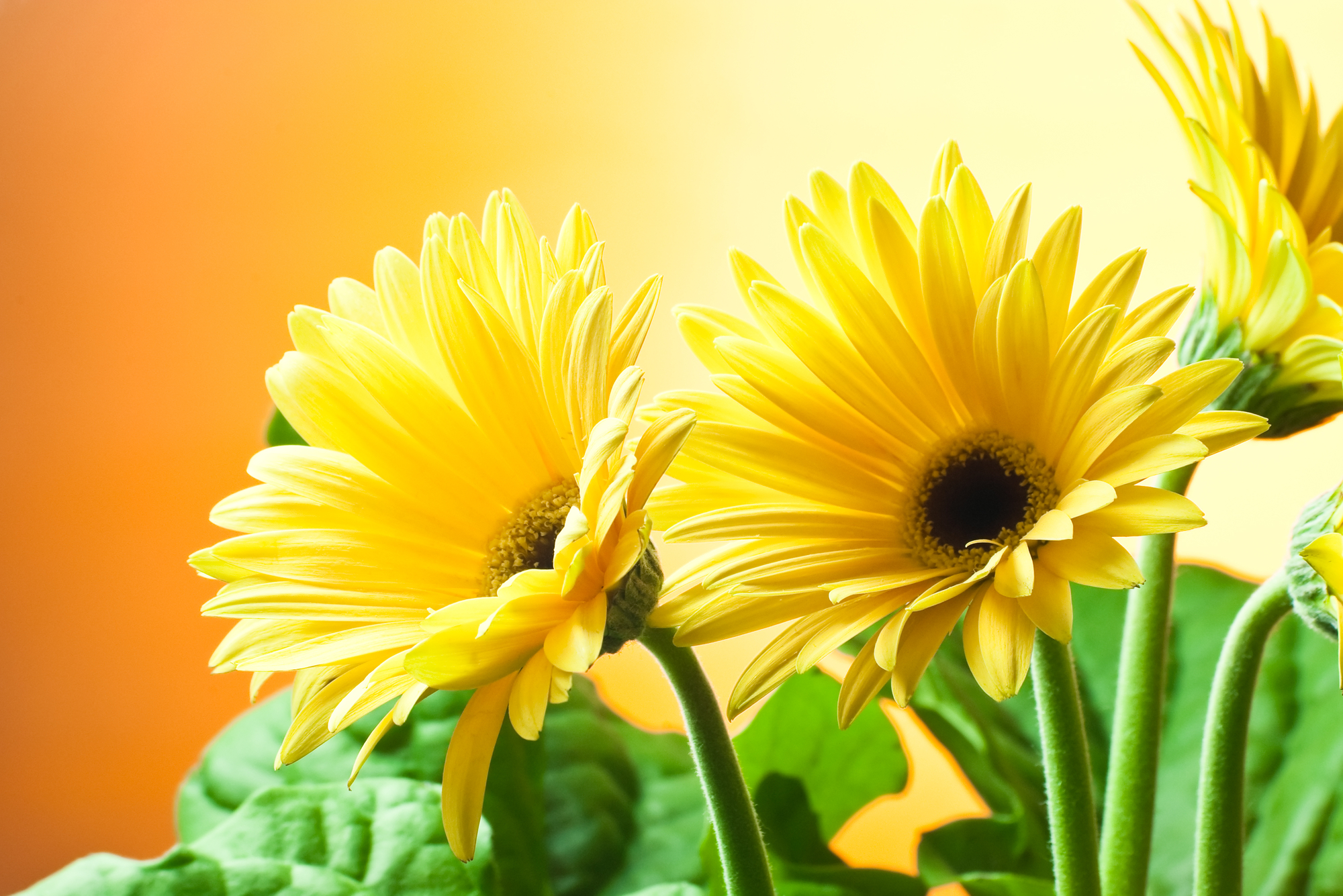
If you’re considering brightening your garden with warmer colors, I suggest using yellow flowers. There are so many types of yellow flowers that you can use or plant to brighten up your place.
Some types of yellow flowers include sunflowers, begonias, marigolds, carnations, ranunculus, daffodils, and freesias. Additionally, you can find yellow versions of popular flowers such as daisies, roses, orchids, water lilies, and tulips.
If you want to know more about all the different types of yellow flowers you can add to your garden, read below. I will explain a little bit about each one, giving you ideas on what is more suitable for your home or garden.
37 Various Yellow Flowers for Your Garden
1. Sunflower
(Helianthus annuus)
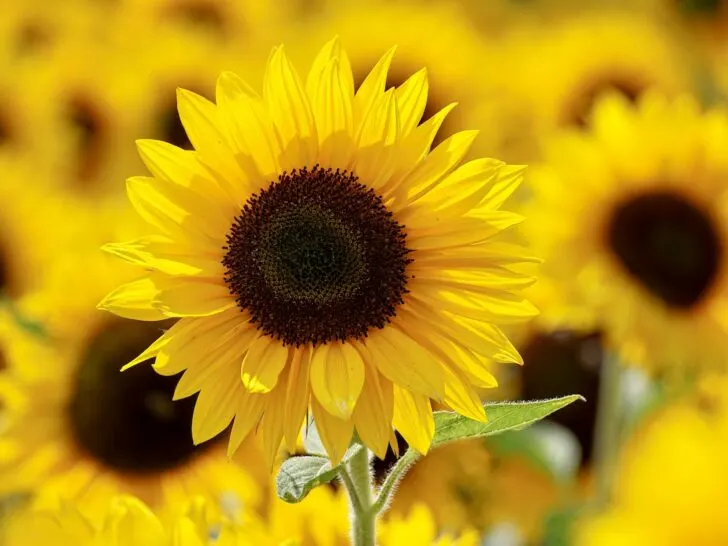
The bright, beautiful yellow color of sunflowers can always bring a pop of color to your yard. Sunflowers bloom in late summer and early fall. These flowers need direct sunlight to grow, but other than that, they require very basic care and maintenance.
2. Petunia
(Petunia hybrida)
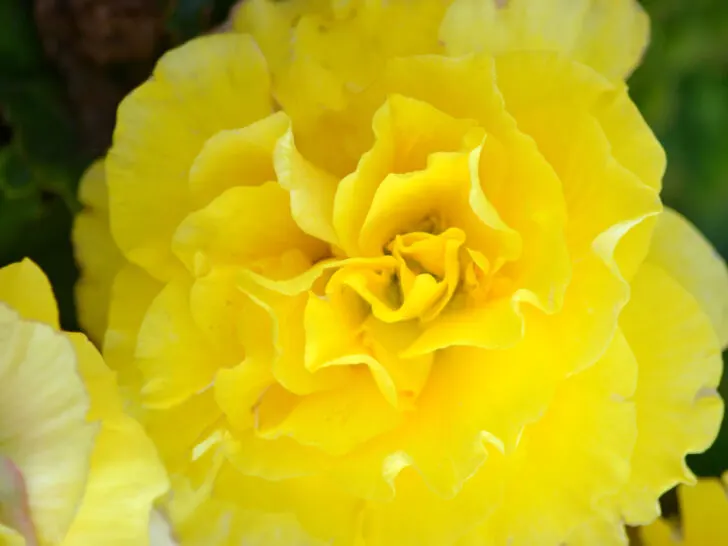
Petunias are favorites among flower bed plants. Their delicate trumpet shape and vivid colors can transform the look of your garden. They bloom in spring and remain well into winter, but they can last for a few years in warmer climates.
3. Calendula
(Calendula officinalis)
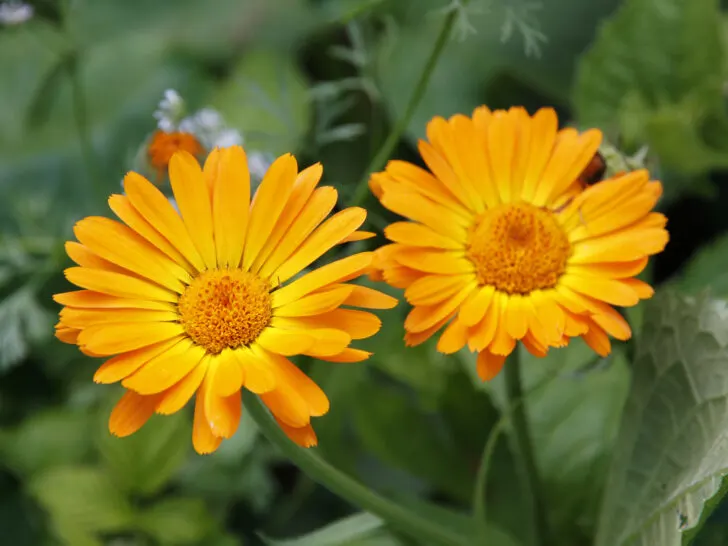
Calendulas are beautiful, deep yellow flowers that brighten up your garden as soon as they bloom, which is generally from midsummer until mid-winter.
To take care of your calendulas, you should know that they don’t do well in high temperatures or highly humid conditions.
4. Black-eyed Susan
(Rudbeckia)

Balck-eyed Susans are wildflowers with bright yellow petals and a very prominent “black eye,” in addition to deep green leaves. They usually bloom from June to September.
5. Begonia
(Begonia obliqua)
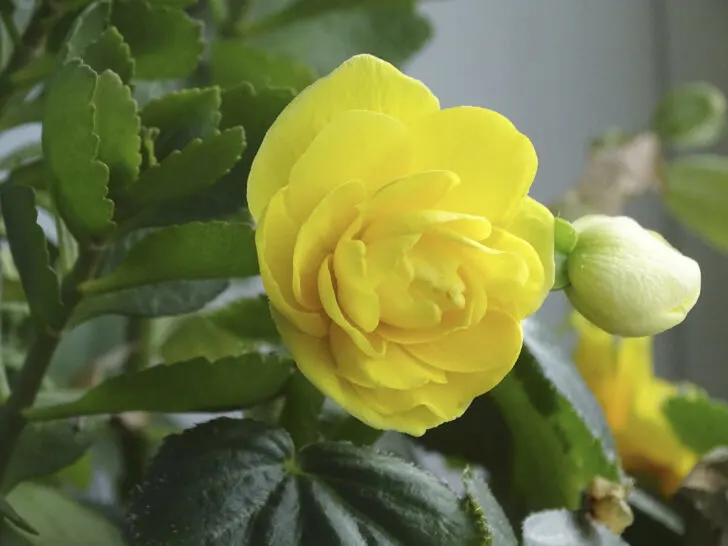
Yellow begonias are stunning tuberous flowers. They grow in clusters, offering beautiful pops of color in your garden. These flowers usually bloom every summer. Begonias require partial shade and highly fertile, moderately moist soil.
6. Mecardonia
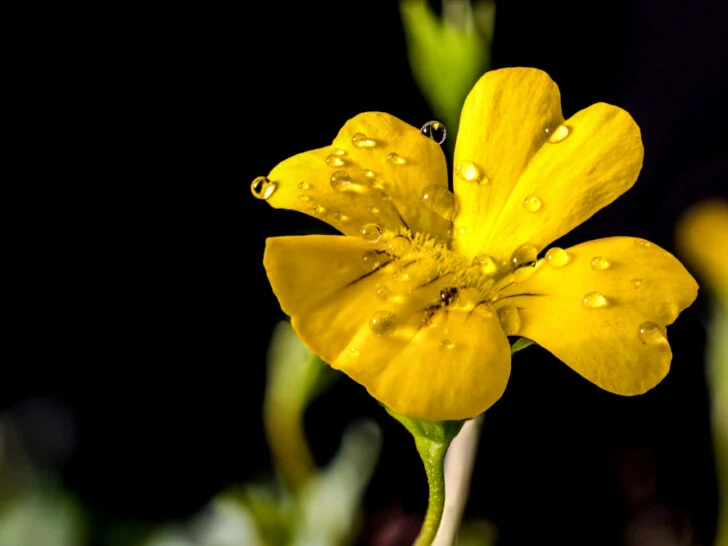
(Mecardonia procumbens)
Mecardonias are small golden yellow flowers that grow in groups, earning the nickname “gold dust” because of their appearance. They grow from early spring to early winter.
It’s pretty easy to take care of mecardonias; you just need to ensure the soil is fertile and well-drained.
7. Dahlia
(Dahlia)
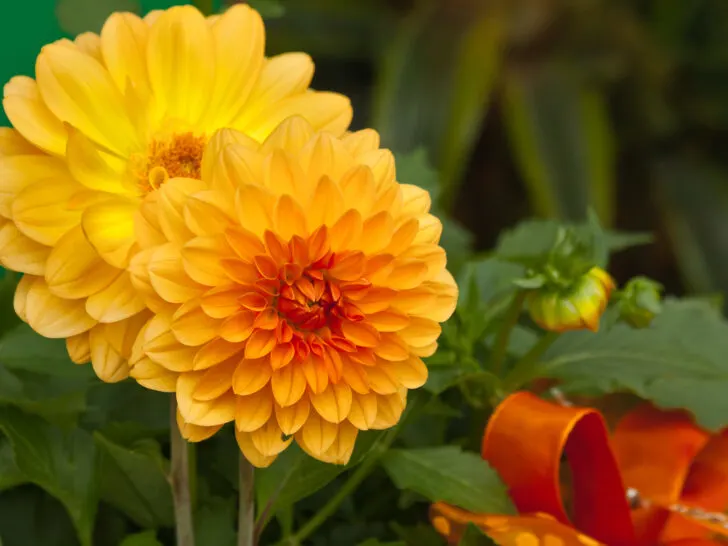
You might mistake dahlias for sunflowers, and for a good reason, they are in the same family. Their bright yellow petals and arrangement are similar, although dahlias have a more intense look. Dahlias bloom from late summer until late fall. Like sunflowers, dahlias also like sunshine.
8. Yellow Rose
(Rosa)
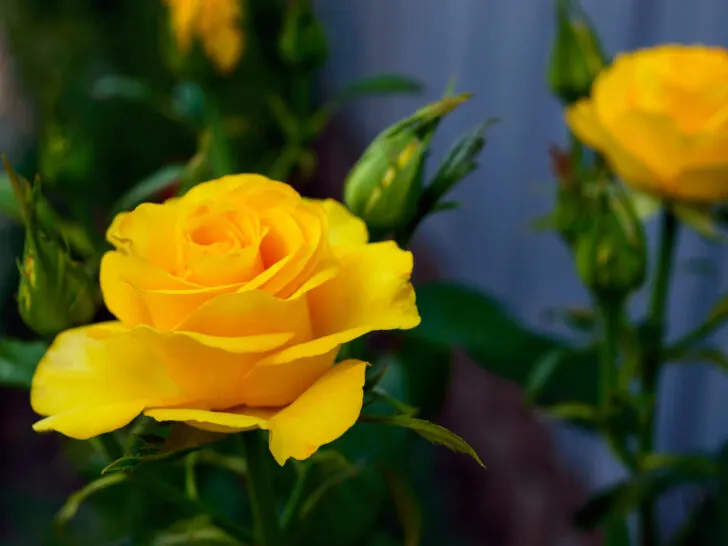
Yellow roses may not be the most widespread color, but they offer an excellent golden addition to your garden. Roses bloom from spring to early fall. They like sunlight, but they can also grow in half shade.
9. Water Lily
(Nymphaea Hollandia)

Water lilies are grown in freshwater. Yellow water lilies have bright yellow centers and paler outer petals, surrounded by characteristic large lily pads. They bloom from late spring to early fall.
Water lilies require slow-moving water and a warm climate to grow.
10. Chrysanthemum
(Chrysanthemum)

Yellow chrysanthemums have a deep yellow color similar to sunflowers and have a potent and pleasant aroma. They usually bloom from midsummer to mid-fall.
Chrysanthemums need a lot of sunlight and constant watering.
11. Moss Rose
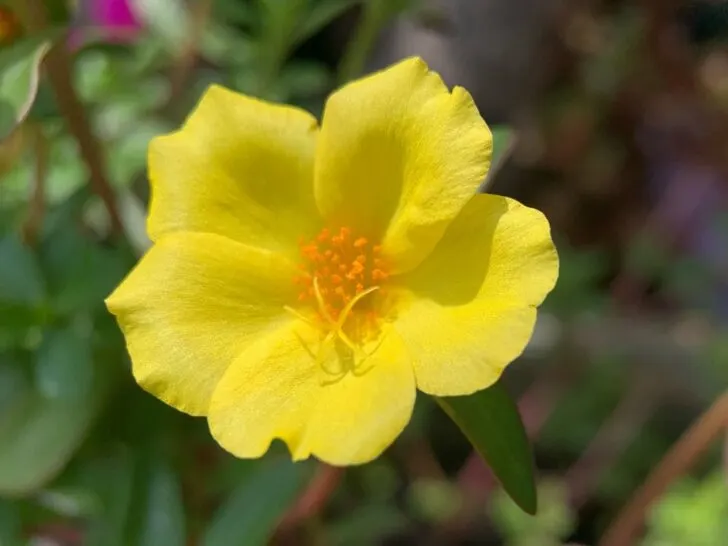
(Portulaca grandiflora)
Moss Rose resembles a type of moss because of its small leaves. Yellow moss roses have deep yellow petals with reddish centers. They grow from early spring until late fall.
Moss roses are very sturdy, being able to survive even harsh and dry conditions.
12. Ranunculus
(Ranunculus asiaticus)
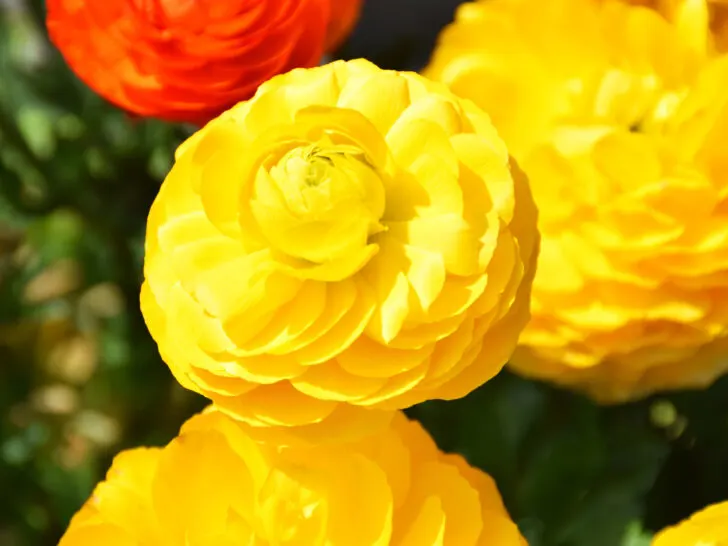
The bright yellow color of ranunculus flowers is striking, but their shape is also quite peculiar, with downward-facing petals. They usually bloom in late winter and early spring.
Ranunculus flowers are hardy, but they need some care. They should be kept moist but not wet, and they prefer highly fertilized soil.
13. Daffodil
(Narcissus)
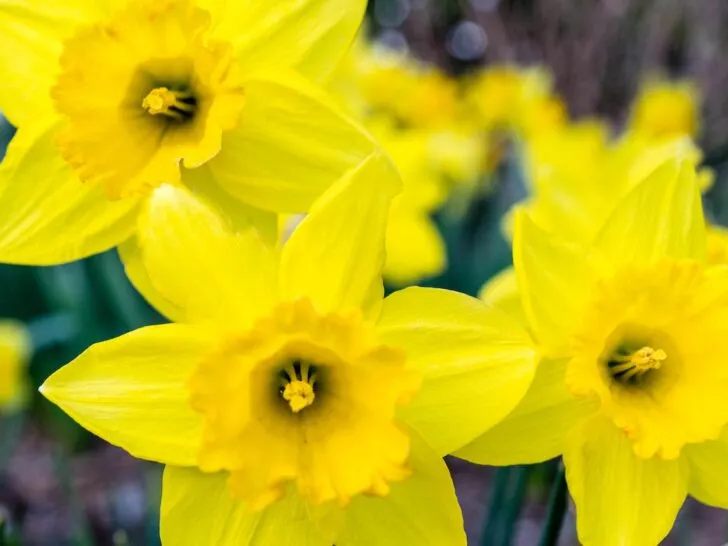
You might be more familiar with the white daffodils. Yellow daffodils have a unique trumpet-like shape and a beautiful, deep yellow color. Daffodils bloom in late winter.
You should ensure that the yellow daffodils grow under full sun, but half shade may also work.
14. Marigold
(Tagetes)

Marigolds are also quite popular flowers. Their wonderful golden petals arranged in pom-poms and their sage green leaves make for a stunning display in your garden. Marigolds grow from early summer to mid-fall. They are sturdy flowers that can resist even dry conditions.
15. Orchid
(Orchidaceae)
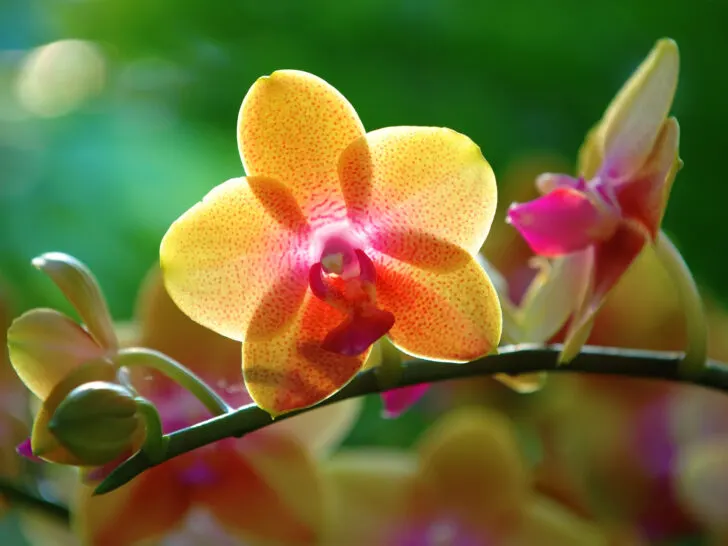
Yellow orchids have deep yellow petals with fuchsia centers, creating a colorful treat for the eye. During early spring, daffodils start blooming and continue for months. Orchids prefer half-shade and moderately high temperatures.
16. Yellow Tulip
(Tulipa)
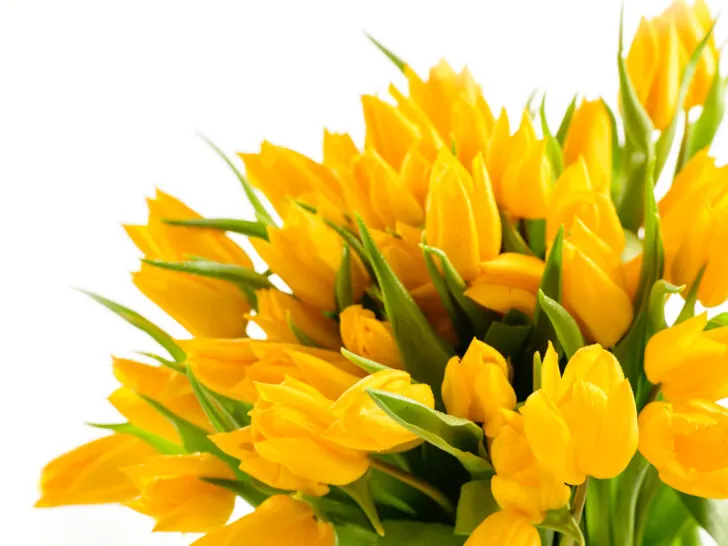
Yellow tulips are a popular variety of tulips, with large, delicate bright yellow petals and sharp green leaves. They usually bloom around early spring.
Tulips like the sun, but they can’t withstand much heat.
17. Carnation
(Dianthus caryophyllus)
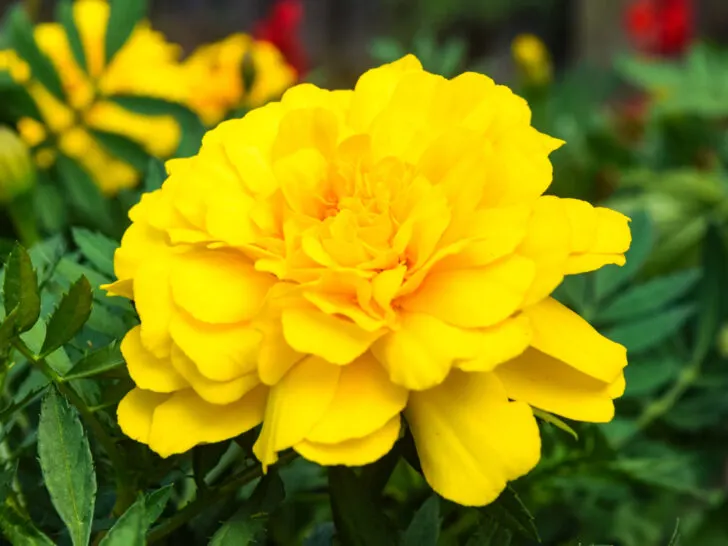
Yellow carnations have a deep yellow center and reddish peripheries, creating a very aesthetically pleasing combination. These flowers start to bloom around late spring.
The most suitable soil for yellow carnations should be alkaline and moderately moist.
18. Bidens
(Bidens)

Bidens have bright yellow petals, deep orange centers, and evergreen leaves, providing vivid colors for your garden every season, particularly in warm climates. They usually bloom from spring to fall.
Bidens don’t require much maintenance, as long as they are planted in rich, well-drained soil.
19. Peony
(Paeonia)
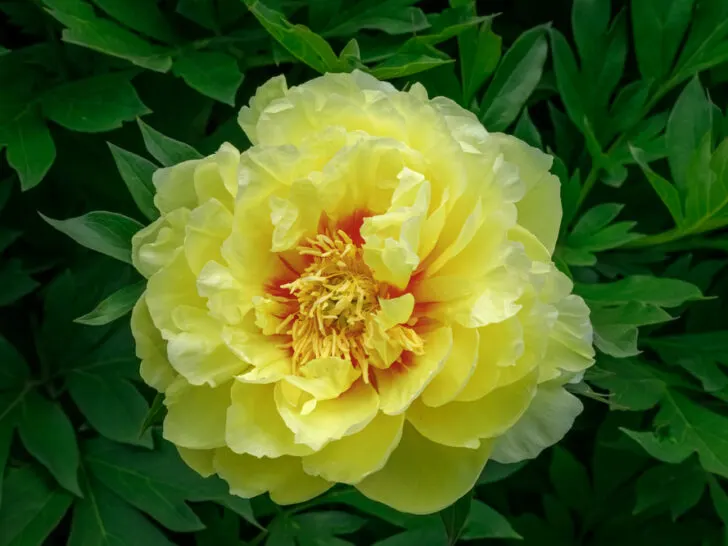
Yellow peonies have a beautiful yellow color with a brighter center and paler outer petals. Peonies usually bloom in spring until early summer.
Peonies are a little delicate, requiring more care than other flowers. Make sure to plant them away from any large plant that would compete for food.
20. Zinnia
(Zinnia elegans)
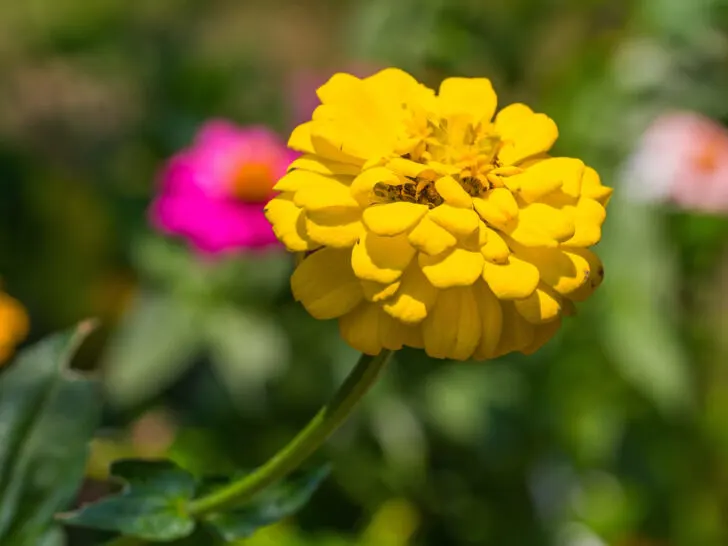
Zinnias are similar to daisies in structure but with rounded petals and deep yellow-orange color. They bloom from mid-summer until winter, and they grow very quickly.
Zinnias prefer full sun, but they can also grow in part shade, especially in warmer climates.
21. Iris
(Iris pseudacorus)

Yellow iris flowers have bright yellow petals and long sharp leaves, sitting in large groups on peduncles. These flowers usually bloom from late spring to midsummer.
Irises prefer full sun or part shade. The soil should be quite moist, acidic, and rich.
22. Pansy
(Viola x wittrockiana)
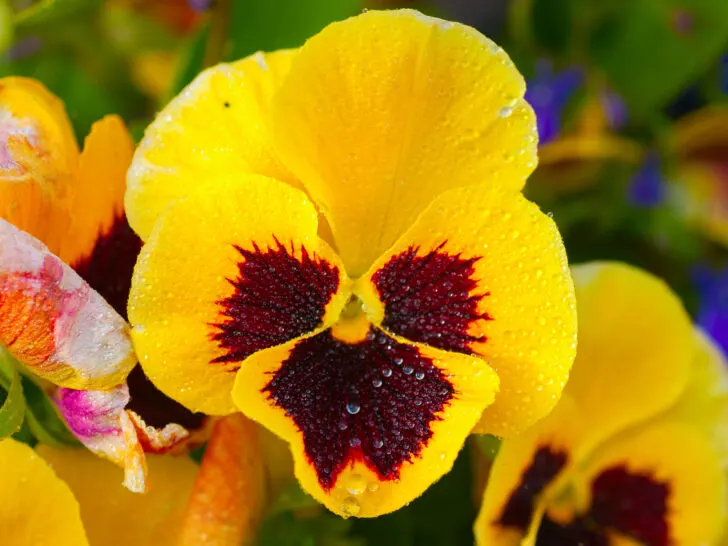
Yellow pansies are large, deep yellow flowers with overlapping petals. Pansies can bloom twice a year, in fall and early spring.
You don’t need to worry much about pansies; they require little care. They prefer direct sunlight or partial shade and lower temperatures.
23. Snapdragon
(Antirrhinum)

Snapdragons are known for their unique shape that looks like a jaw. Their color is pale yellow outside and deep yellow near the center. You can find snapdragons in full bloom in spring or fall.
Snapdragons can bloom in partial shade and full sunlight, but they stop blooming once temperatures get high.
24. Prickly Pear
(Opuntia humifusa)

These beautiful flowers grow on very prickly cacti. They have vibrant yellow petals on top of large cacti with sharp spikes. Prickly pears can bloom around late spring or early summer, only once a year.
Prickly pears are pretty sturdy; they thrive in colder climates and dry soil.
25. Gerbera Daisy
(Gerbera jamesonii)
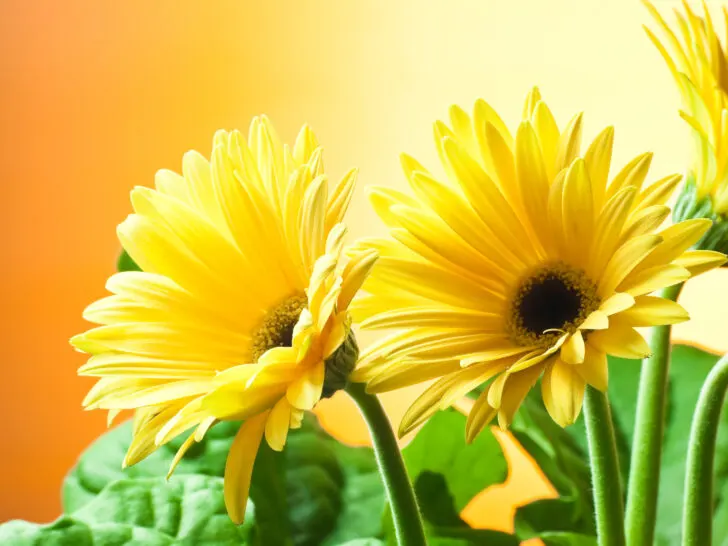
Yellow daisies resemble sunflowers, with long yellow petals and a darker center. Gerbera daisies are in bloom throughout summer.
Yellow gerbera daisies require full sunlight and nutrient-rich soil.
26. Freesia
(Freesia)
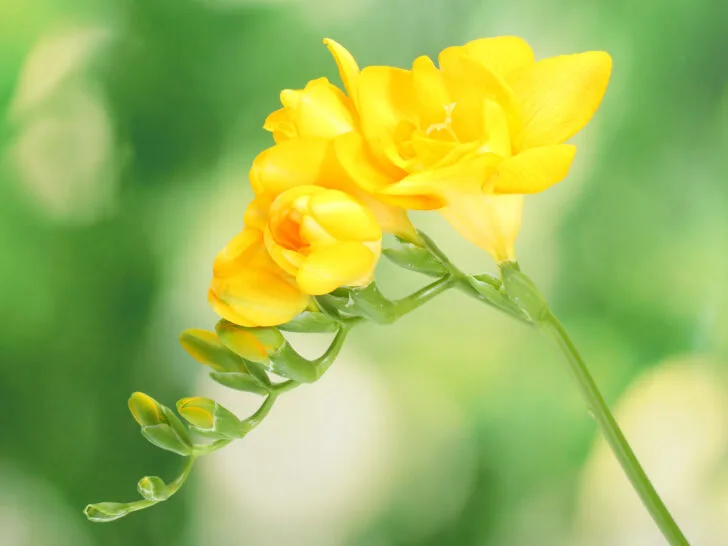
Freesias are all yellow flowers with delicate petals and long thin foliage. They are known for their strong and pleasant aroma. You can plant freesias during fall and expect them to bloom around late spring until fall.
Freesias can rot pretty quickly, so make sure not to overwater them and to plant them in soil that doesn’t retain moisture.
27. Goldenrod
(Solidago virgaurea)

Goldenrods grow in bundles of tiny little golden flowers. They can provide your garden with the pop of color that it needs. Goldenrods bloom throughout the summer and don’t require watering or feeding; all you need to do is deadhead them once in a while.
28. Bear’s Ear
(Primula auricula)
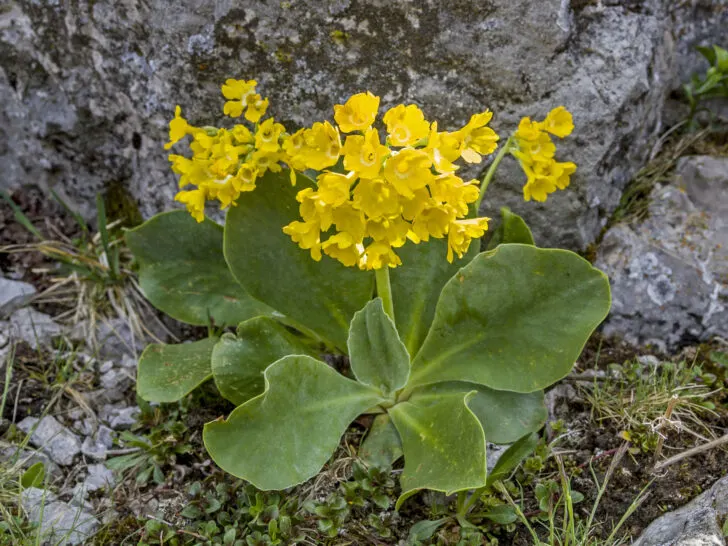
Bear’s ear flowers look striking, especially with their large, bright green leaves. Bear’s ear flowers usually bloom toward the end of summer.
These flowers grow naturally around rocks, so they’re sturdy and don’t require much maintenance.
29. Hibiscus
(Hibiscus rosa-Sinensis)
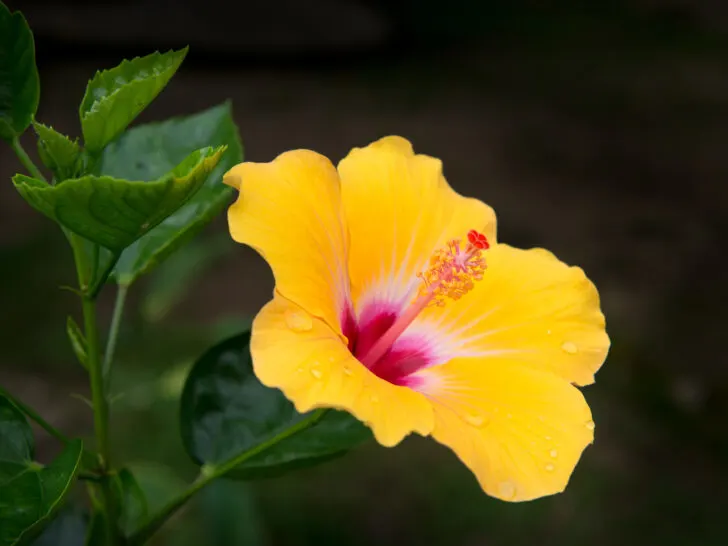
Yellow Hibiscus flowers have large, vibrant yellow petals that circle a reddish center, creating a beautiful combination with the dark green foliage. You can usually find hibiscus flowers in full bloom by late summer.
Make sure your hibiscus flowers are placed somewhere with lots of sunlight and are constantly watered.
30. Primrose
(Primula)
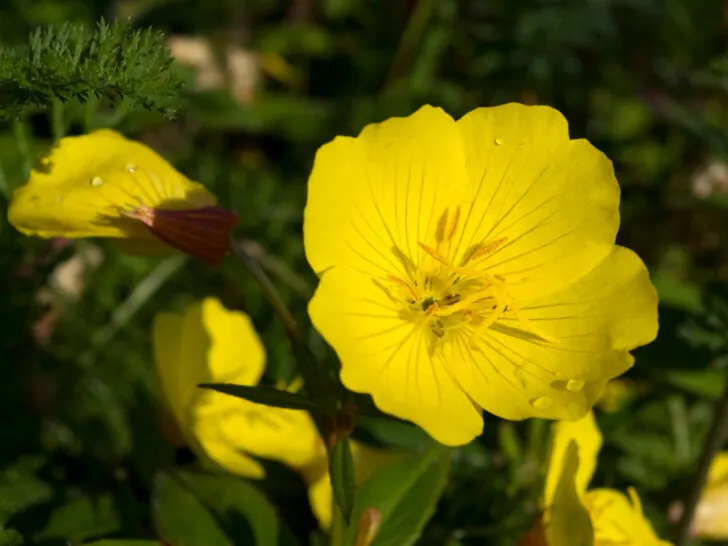
Primrose flowers have yellow heart-shaped petals and tall stems; you can find them in the wild, around the woods. They usually bloom from spring to summer, but they can last longer if you live in hot climates.
Make sure your primrose flowers are planted somewhere with lots of shade since they don’t seem to enjoy the sunlight.
31. Bird of Paradise
(Strelitzia)
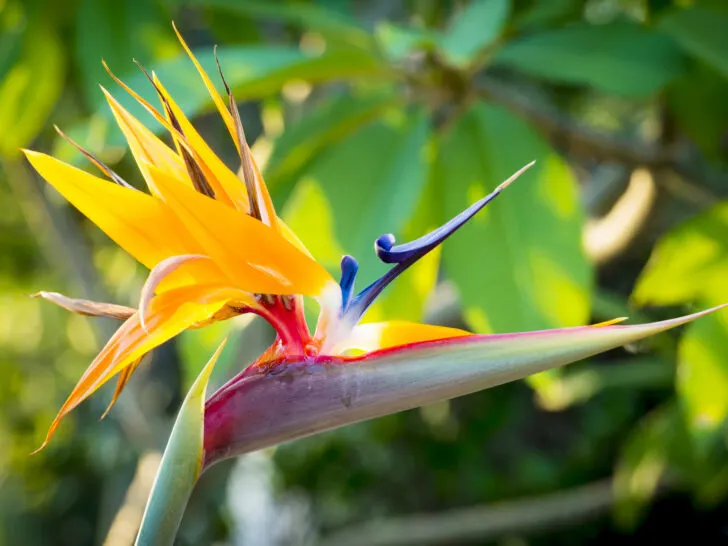
This flower is easily recognizable because of its shape, which resembles a bird, and the pointy vibrant yellow petals resting on a green petiole. Bird of paradise flowers blooms in early spring.
Because they are originally from a tropical climate, these flowers require sunlight and moderately high temperatures.
32. Dutch Hyacinth
(Hayacinthus orientalis)
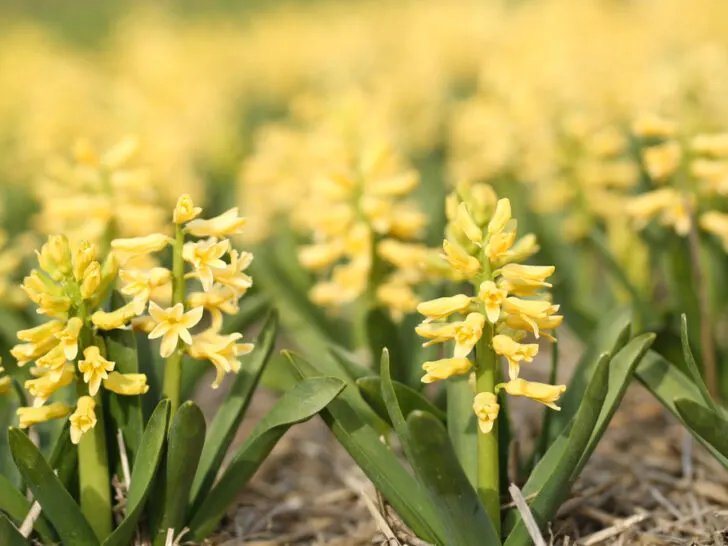
Hyacinths make for great garden plants, with bundles of tiny flowers that create a striking, ball-like shape that emerges from a thick stem. They are usually a pale yellow, almost pastel. Dutch hyacinths bloom in early spring.
They enjoy full sun, but they can also grow in partial shade.
33. Jungle Geranium
(Ixora coccinea)
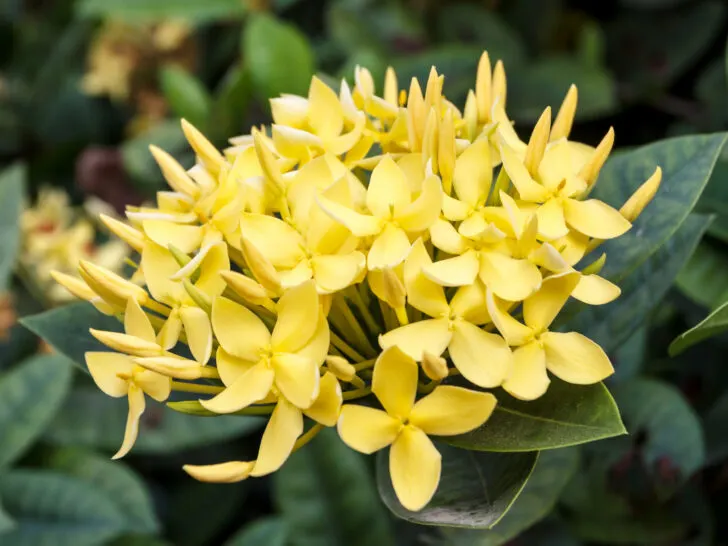
Jungle geranium flowers grow as bundles of small trumpet-shaped flowers with long petals. They are more recognizable in their red variety, but you can get them in deep yellow. Jungle geranium flowers bloom during the summer.
34. Purslane
(Portulaca oleracea)

Purslane flowers are tiny specks of yellow among thick green leaves. Although very small, the flowers have a bright yellow color and heart shepherd petals. You can see purslane flowers blooming from late spring until the end of summer. Make sure not to overwater them.
35. Oleander
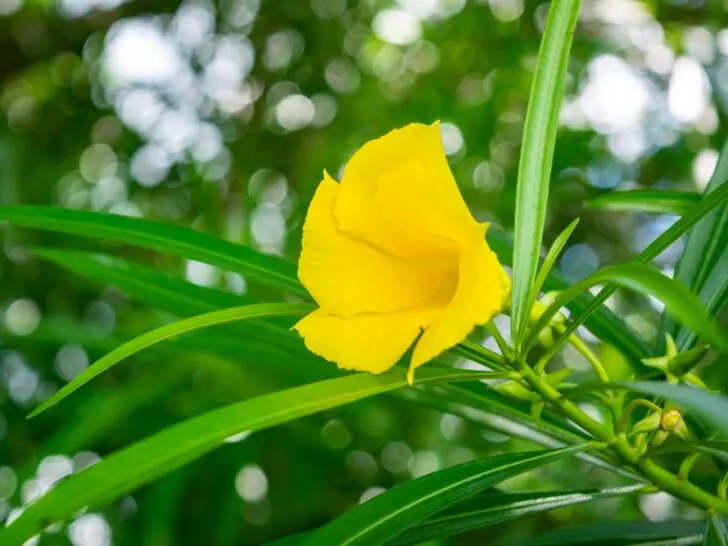
You’ll definitely brighten up your garden with some yellow oleanders! They have a vivid yellow color and wonderful, pinwheel-like petals. Oleanders usually flower at the beginning of the summer and last until mid-fall. These flowers are pretty resistant to droughts, but not to low temperatures.
36. Blanket Flower
(Gaillardia x Grandiflora)
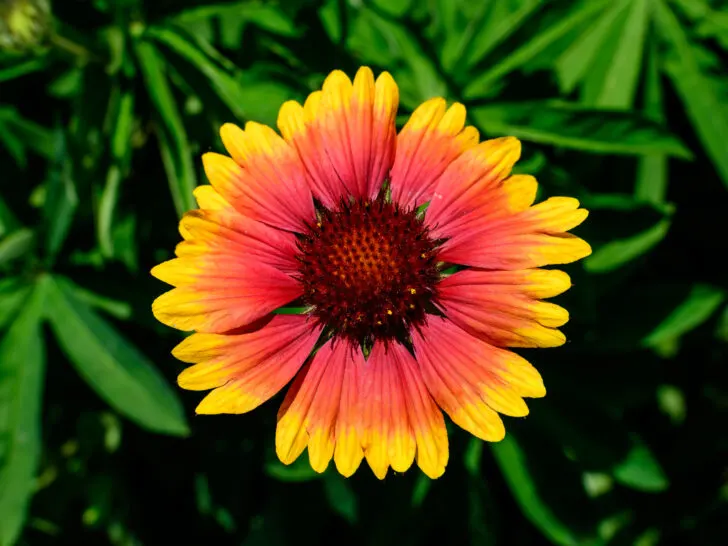
The impressive yellow-red combination of these flowers is nothing short of gorgeous. The deep red center slowly fades into yellow toward the outer part of the petals. Blanket flowers bloom in early summer and can last until winter if you deadhead them. They don’t require much moisture.
37. Bulbous Buttercup
(Ranunculus bulbosus)
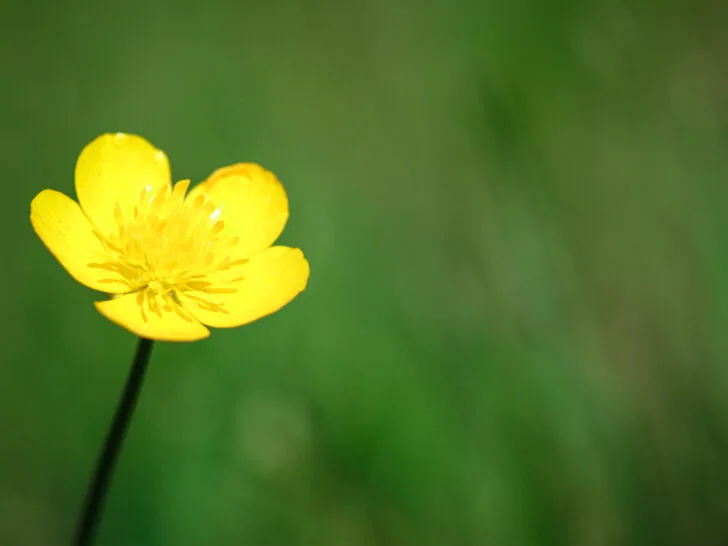
Bulbous buttercups have a simple shape but very bright yellow petals with a shiny buttery texture. They are small and can grow in fields during spring. They are resistant, but they need direct sunlight.
Frequently Asked Questions
If you have additional questions about all these different flowers, see if you can satisfy your curiosity below:
Do Yellow Flowers Attract Insects?
Several factors may cause insects to be attracted to a particular flower. However, if we only consider color, it’s believed that yellow flowers are attractive to many insects, including bees, flies, and certain moths.
What Is the Most Popular Yellow Flower?
There is no correct answer to this question because it depends on the season and the area. However, generally speaking, sunflowers are usually the first flower that comes to mind when yellow flowers are mentioned.
Are Yellow Flowers Lucky?
Although some people consider yellow an unlucky color, yellow flowers are considered a sign of good luck in some cultures. These flowers are usually given to friends as a symbol of love and harmony.
Final Thoughts
Yellow flowers can provide much-needed brightness in your garden. You can choose from plenty of options, like marigolds, daffodils, daisies, carnations, chrysanthemums, sunflowers, and many more.
In any case, take care of them by planting them in the appropriate soil and making sure they receive the right amount of sunlight and water.
Other Articles You May Be Interested in
51 Beautiful Types of White Flowers
59 Beautiful Types of Blue Flowers
